Cyrus Cylinder Primary Source Jigsaw Reading Activity
- PDF
What educators are saying
Description
The Cyrus Cylinder is a document issued by Cyrus the Great in 539 BCE when he conquered the Neo-Babylonian Empire. I use this document in my 6th grade Ancient History classes when we study Ancient Mesopotamian empires. It is clearly propaganda, as are most proclamations commissioned by ancient (and modern) leaders, but we can learn quite a bit about how Cyrus ruled from this document.
This product includes primary source text in 4 different sections, at different reading levels. It includes instructions for how to use this text as a Jigsaw Activity if you'd like, and it also includes guiding questions, and a summary response.
I have never been able to find quality teaching resources about the Cyrus Cylinder, so I was excited to create this activity for my own classroom. The Cyrus Cylinder is arguably the first attempt at codifying human rights, and it is an incredibly important piece of the story of human civilization. I hope your students love learning about Cyrus as much as mine did!





